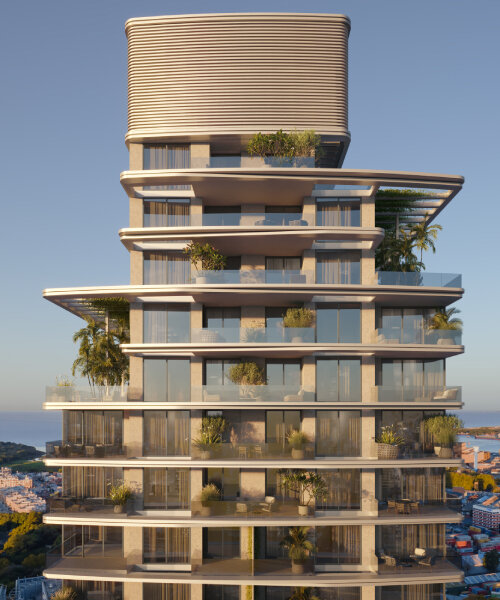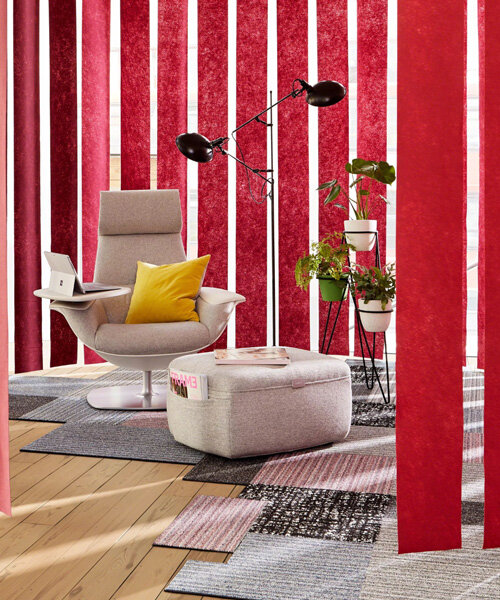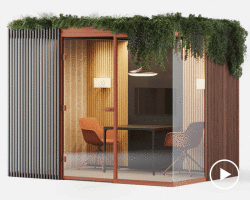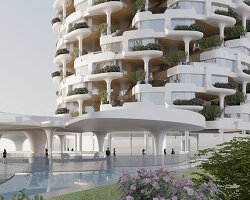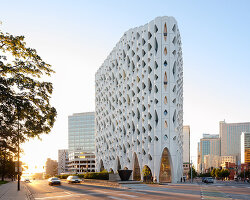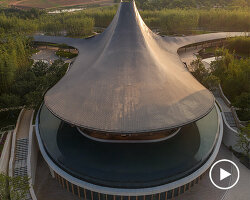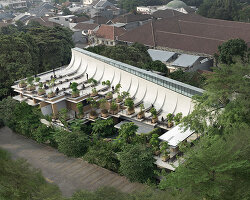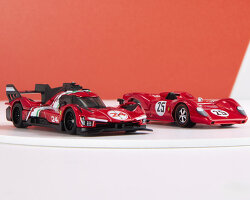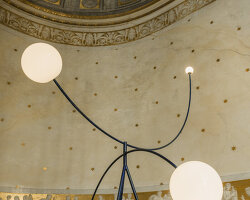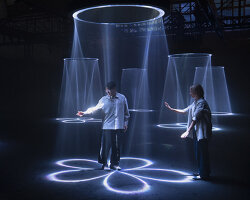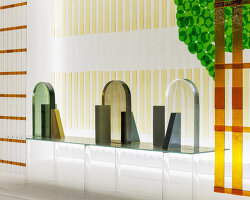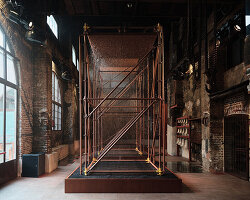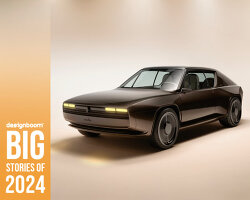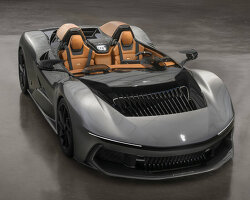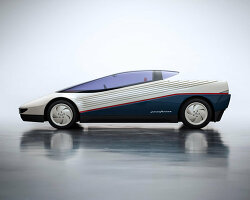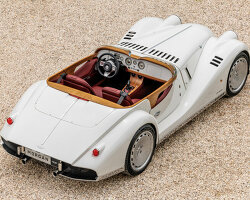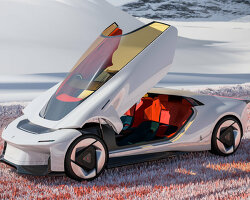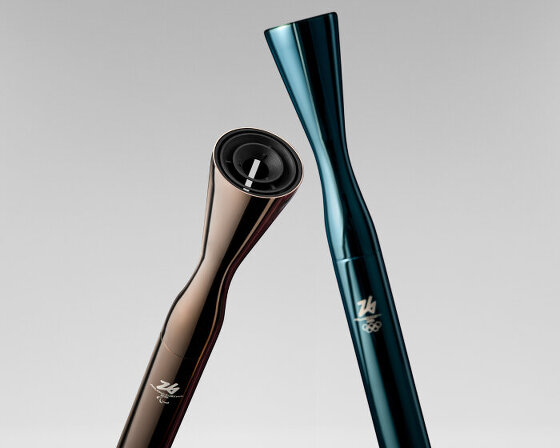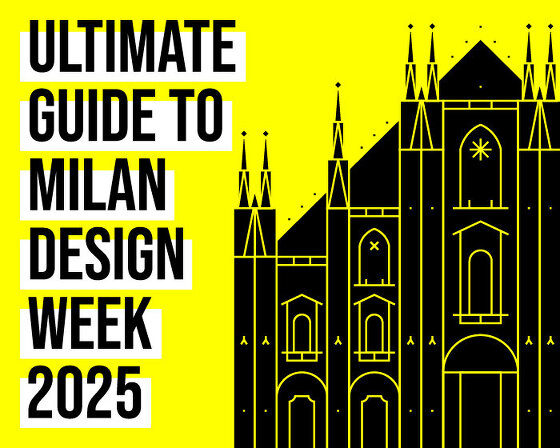Pininfarina of america extends their office to miami
Pininfarina of America takes designboom behind the scenes, from their ways of working on projects to a few of their recent collaborations resulting in biophilic towers, an automotive country club, a nature-inspired kitchen collection, a boat with a large cockpit, a lighting activation and installation at Design Miami 2024, and more. It may be known that Pininfarina, a multidisciplinary design studio, has headquarters in Italy and is present in major countries, including Germany and China. It’s the Americas that takes the reins this time, introducing the architecture, design, and mobility projects they’ve done so far over the last year.
The three main players of Pininfarina of America are all present during the interview: Claudio da Soller, the General Manager; Paolo Trevisan, the Senior Vice President of Design; and Samuele Sordi, the Chief Architect Officer. It’s a sunny day when designboom speaks with them and a fruitful season for the three since they just opened the doors of their headquarters in Miami on October 1st, 2024. It sits on a small, residential island, and it’s mainly covered in glass and divided into open spaces. Greenery surrounds the building, and if the creatives are lucky enough, a dolphin or two can even spring from the sea that’s in front of their office. Setting up the office in Miami is a plus factor for the trio. Their New York branch is a stone’s throw away from their North American operations. Now, it’s easier for them to move to and from South America, where some of their recent collaborations and projects have arisen.
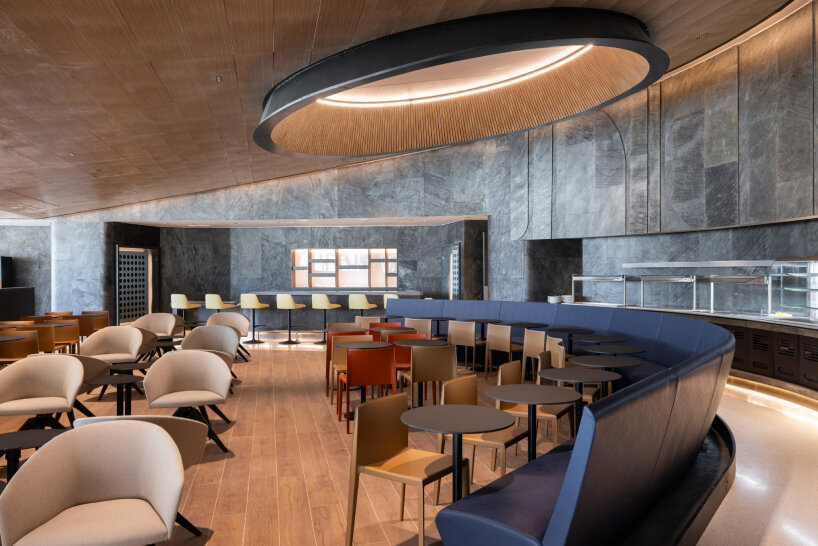
Primeclass Pacifico Lounges in Chile | all images courtesy of Pininfarina of America
Biophilic design isn’t just about greenery, vegetation and plants
For a team that’s booked and busy, Claudio, Paolo, and Samuele are quite laid-back, and it may be that cool yet commanding presence and thinking that have allowed for a series of their recent projects to come to life almost consistently. In 2024 alone, they’ve unveiled the five Primeclass Pacifico airport lounges at the Arturo Merino Benítez International Airport in Santiago de Chile; the Unica residential tower in Puerto Madero, Buenos Aires; and the Maringa Tower in Brazil, which is the first of the five projects Pininfarina of America is set to develop alongside Plaenge. They may be in different countries, but they’re tied by a unifying theme: biophilic design.
Pininfarina of America tells designboom that biophilia in design is more than just about greenery, vegetation, and plants. It’s an approach that should allow people to stay in contact with nature to help them live in better-built environments. It can come through the round exterior edges and ladderized plants on the balconies of the Maringa Tower. It may mimic the patterns of water when it sloshes and flows, similar to the team’s approach to the building facades and fences of the Unica tower, inspired by the Rio de la Plata river near the site. Natural materials like wood can become prominent too to bring in an earthy feel, and the Pininfarina of America team applies just that to the Primeclass Pacifico lounges.
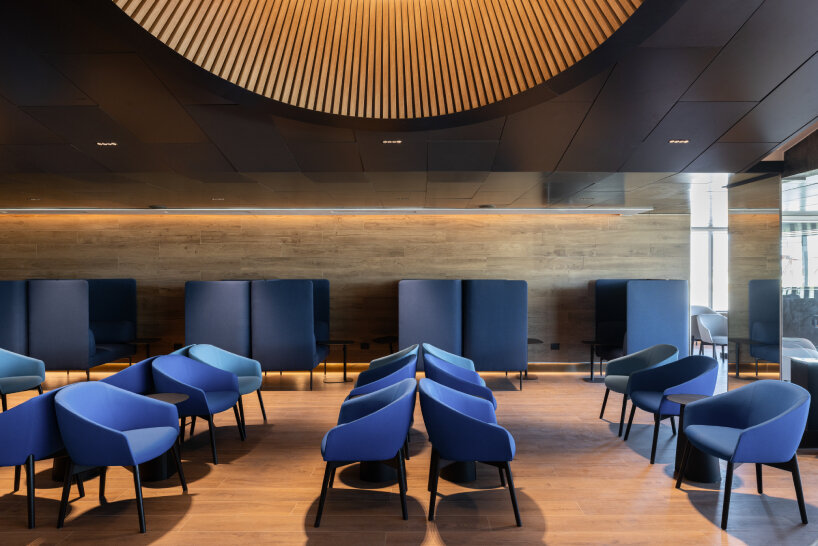
Primeclass Pacifico Lounges at the Arturo Merino Benítez International Airport in Santiago de Chile
Pininfarina of america in mobility, country club, and more
Repetition isn’t something Pininfarina of America wants to live by (that, and copying and pasting designs from their previous projects). So, when they take on collaborations, there has to be a variety, and that’s exactly what happens now that they’ve dabbled in mobility, country club, lighting design, and even kitchen collection. On water, they have the NX 44, a boat with a living space, two large cabins, a sunbed, and a connected interior and external spaces using glass doors and divisions. On land, they bring in the Electric Transformer House, an RV that has an expandable cabin and solar roof for a wider, on-road living space.
There’s an automotive country club too that’s underway, expected to be completed in December 2024. They collaborate with the Concours Club in Miami to design an events campus, located on site at the driving facility. It is its own venue space, but it’s also the pathway leading to the club’s ski pad and pit entry. Out of the club and into the kitchen industry, they’ve worked with ARCO to come up with a nature-inspired kitchen collection in four colors and ranges. It’s dressed up in aluminum, and there are singular, curved glass doors for the pantry to draw away the attention from the pastel colors for a moment. To top these recent projects off, the Pininfarina of America is set to reveal their collaboration with VISO for a lighting design, installation, and activation at Design Miami 2024.
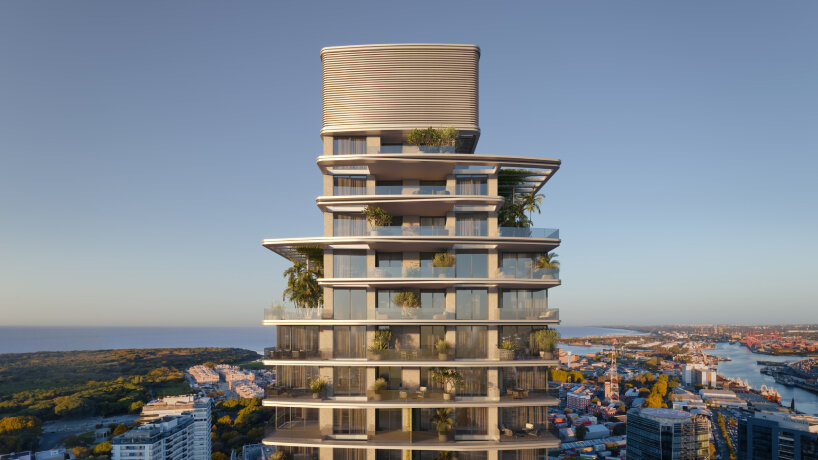
Unica Tower in Buenos Aires, rooftop view
The collaboration between Pininfarina of America and VISO takes invited visitors at Design Miami 2024 back to their earlier days. It’s a reminiscing take on childhood dreams, a playful and exclusive installation that partly shies away from their other nature-driven projects. What Paolo and Samuele can tell designboom as of publishing the story is that the light activation and installation are similar to a child lying in the grass, looking at the clouds. Instead of curvy white puffs, these ‘clouds’ are lighting designs shaped in different forms, luring in the viewers to think back to the days when they were younger, tap into their childlike energy, and reflect on their future. And that’s how Pininfarina of America concludes the call with designboom: a lookback to who they wanted to be and what they are today.
Samuele would watch his uncle use his airbrush to spray paint his designs and thought he would be a designer, but growing up in Florence, the architecture inspired him more, compelling him to pursue architecture later on. Claudio, like most Italian boys, imagined himself to be a soccer player playing for his country, but in his words, it’s unfortunate he didn’t have the skills to do it, so now he’s in Pininfarina of America, taking care of the business side. It might only be Paolo whose childhood dream match what he does: he wanted to be a carpenter – a child who loved the wood, the cars, and the process of creating – and now he’s a Senior Vice President of Design. Our conversation with Pininfarina of America slowly steers towards their creative and creation process more than the projects they’ve done. Reading below, we’re fortunate to be let in on their design principles when they work on a project, how their collaboration works, and what their recent Miami office means to their business, among other discussions.
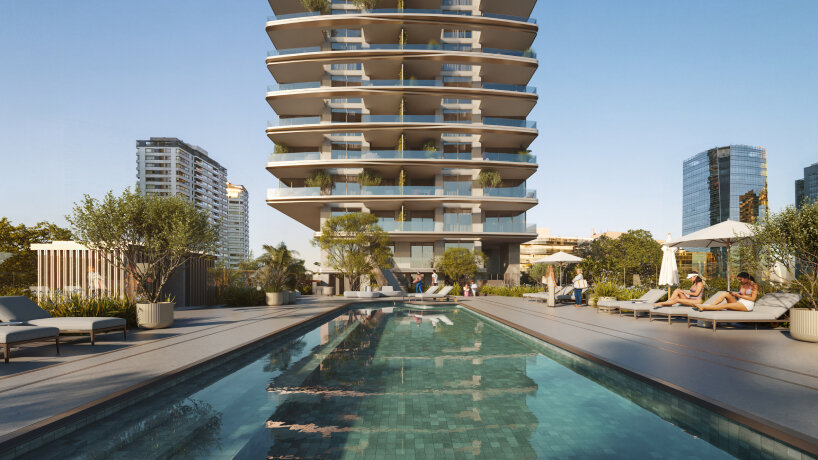
Unica Tower pool and building view
Interview with Pininfarina of America
designboom (DB): Claudio, Paolo and Samuele, it’s wonderful to see you all here. We heard that the Pininfarina of America office in Miami recently opened. What does this mean for the team, Claudio? And what’s the office setting like, Paolo and Samuele?
Claudio Da Soller (CDS): By the way, we did this grand opening one week ago, ten days ago. There was overwhelming enthusiasm from all the attendees, and it was a great event. The office, which isn’t new because it’s an extension of the main branch, is an expansion of the old one, about 5,000 square feet. The layout has been reshaped because we learned a lot from Covid across the world, and we needed to add new components to the architecture and space design—all aimed at team collaboration, open space, and transparency.
We’re a creative design house, so it’s all about collaboration, sparking ideas and focusing on creativity. We also invested in this location. Most of our rooms have huge windows, so natural light flows into the office, which helps the designers in their creative work. Last year, we even saw dolphins! It’s a very cool location on an island here in downtown Miami. Our main purpose was investing in the right environment for a creative team to perform.
On your question specifically, this is a further statement from Pininfarina to invest in this market and be present here. We are a global company, but it’s extremely important to have a local message. So that’s the statement, and the fact that we invested in having this boutique design studio is also a further statement about being closer to our clients. Miami, as you know, is also an important hub, connecting Latin America to the United States, so it’s a perfect location in that regard. That’s my point of view from a business standpoint.
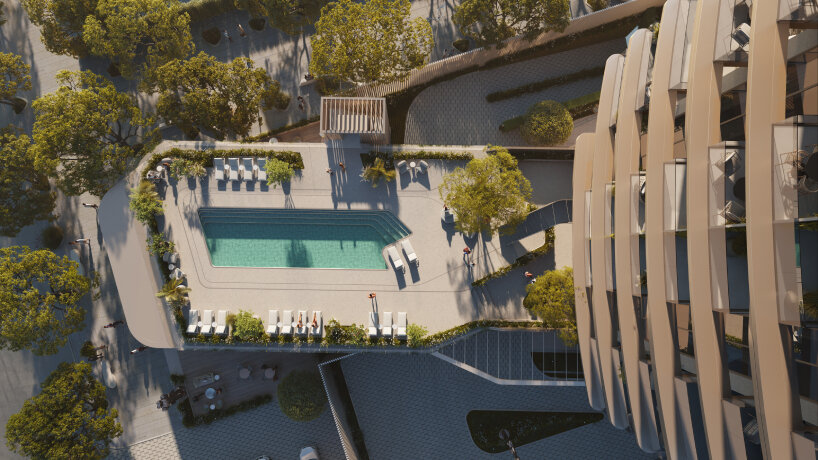
view of the Unica Tower pool from above
Paolo Trevisan (PT): I can be a little nostalgic here. One of the reasons we came to Miami is because Claudio, Samuel, and I had been working together at headquarters in Italy before we moved a few years ago. The reason for our move was the many projects and requests emerging in this area, both in South America and specifically in Miami, where we had a project with Motorola, for example. In industrial design, we had a long relationship with their designers, working on projects like push-to-talk. We also designed air jets in Fort Lauderdale, creating private airplanes one after the other for very special clients. We began an architectural project with the Related Group as well.
From day one, we arrived in the U.S. with a multidisciplinary portfolio attracting clients from different fields. Last year, we celebrated our 10-year anniversary here. Honestly, we always find a good excuse to host an event or party! The office itself is designed to attract talent—not by being large, but by bringing in the best talent, those who understand the spirit of the company. Pininfarina isn’t just a brand; it’s a family surname, with a legacy of 95 years next year. Working at Pininfarina means being passionate, connected to the brand’s story, and having a strong vision for the future. Miami is a very energetic city with many clients from South America, and while we often travel to them, they love coming to visit us in Miami.
The office is on a small, residential island connected by a solid bridge, giving it a unique feel. Architecturally, it’s mainly glass, designed for openness and interaction, with features like full-wall partitions that can be retracted to create larger spaces. We often host workshops with our clients, diving into the experience together with multidisciplinary teams, sitting around a table with a nice view. It’s the best environment to be creative and look toward the future.
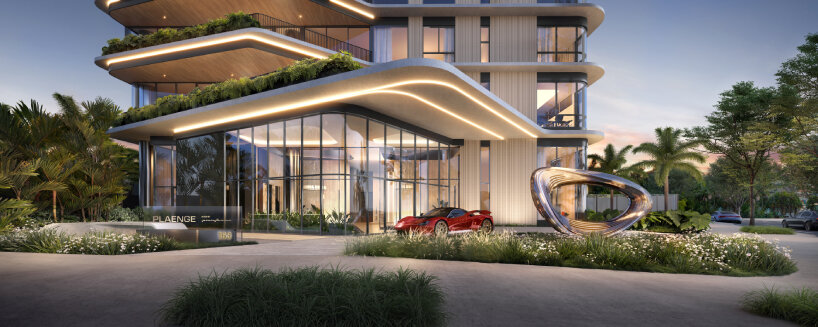
Maringá Tower in Brazil, entrance view
Samuele Sordi (SS): Yes, it’s all about interactions between creative people, as Paolo mentioned. But we’ve also added more private spaces because the way of working has changed. We need small areas for teleconferences or for two-person meetings. People now work a lot from home, so when they come into the office, it’s primarily to interact with others. We have meeting rooms, break rooms, and I’d like to add that our office is also a kind of gallery. The entire space reflects the Pininfarina legacy with various physical models, mockups, and sketches. Everything is really centered on Pininfarina’s heritage, allowing clients to see that we’re among the best designers in the world. For the new generation, it’s a way to truly breathe in what Pininfarina represents. Ten years of history is something very unique, and that’s a special feature of this office.
DB: Congratulations on the new office and celebrating more than 10 years of Pininfarina of America! The building sounds wonderful, and in fact, we notice that there’s this unifying theme of biophilic design and a focus on sensorial well-being to many of your architectural projects, mainly the recent Primeclass Pacifico Lounges in Chile, the Maringá Tower in Brazil, and the Unica Tower in Buenos Aires. Did you specifically choose this approach for these projects? Can’t this cause high maintenance long-term?
SS: When we talk about biophilia, biophilic design isn’t just about green vegetation and plants. It goes deeper, inspired by nature and imitating natural patterns. So it’s not just green; nearly all our spaces are biophilic, inspired by nature beyond just the three you mentioned. All our interior projects, shapes, and forms—from cars to architecture, interiors, and boats—are nature-inspired. There are no 90-degree angles; everything is smooth, shaped as if by natural elements like wind. For us, this is biophilia, an approach that allows people to live better in built environments and connect with nature, even if it’s not through greenery alone.
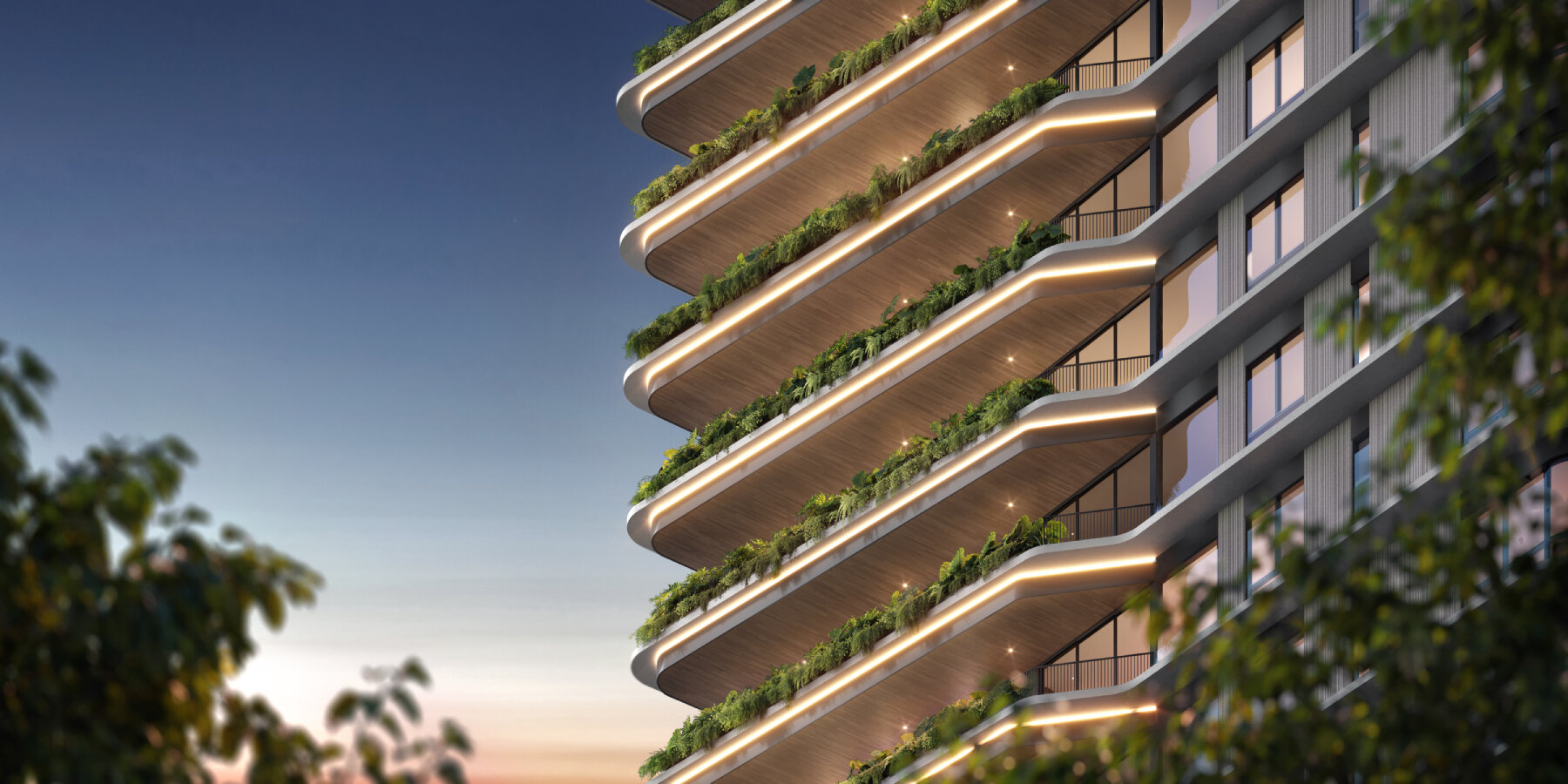
detailed exterior view of the Maringá Tower in Brazil
SS (continued): When it comes to vegetation on facades, we do face challenges with clients on maintenance, but it’s a solvable issue. It requires investment and the right partnerships. Urban forestation is essential for reducing heat islands and enhancing indoor well-being. Well-being is central to Pininfarina’s projects, with design focused on improving quality of life. This approach is consistent across all our projects, regardless of scale, from buildings and interiors to boats and cars.
PT: And today, we have terms like biophilia, but before, it was simply being inspired by nature and human-centered design. This inspiration aligns with what we now call “design thinking.” The term itself may not be as trendy, but the principles of observing and learning remain constant. There’s an emphasis on natural light and organic shapes. Coming from car design, we’ve developed skills to convey emotion through physicality, light, shade, and material changes. In car design, even millimeter adjustments can impact the brand and aesthetic.
Of course, the engine remains crucial. There’s a phrase from Paolo Pininfarina, our founder, that’s significant to us—so much so that we’ve placed it on the wall at our offices. It encapsulates our mission: to humanize innovation. This focus on humanization is key, whether we’re designing architecture, products, boats, or airplanes. We’re interested in designing moments, anticipating how people will create memories and experience special moments. Biophilia as a term applies here, but for us, it represents something much larger, in a broader interpretation of the word.
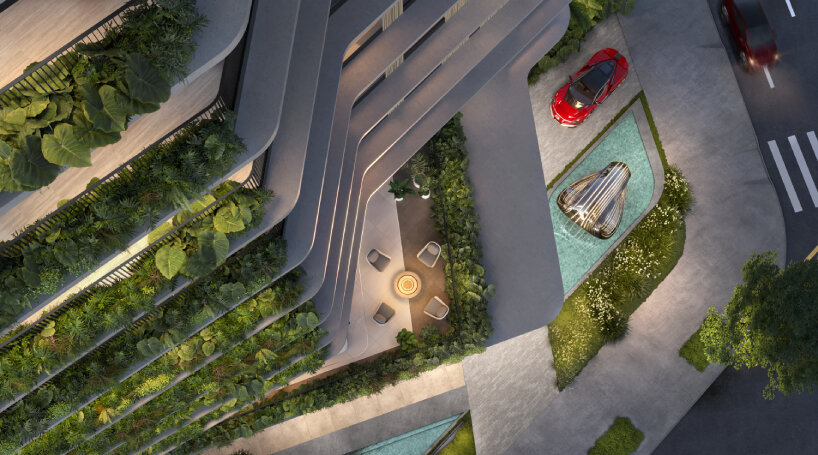
Maringá Tower in Brazil
DB: Speaking of design principles, Paolo, did you base the designs of these projects on a particular set of principles, or did you create your own specifically for these projects, aside from the innovation aspect with Paolo?
PT: We don’t like copy and paste. We are not about repetition. We prefer reinterpretation to understand the context, the client, and the different situations. It’s always different. Even if we do a building on an island or across the street, it’s already a different audience and a different request. We have our principles. One of the things we look for is elegance, which means proportions and equilibrium or disequilibrium. Elegance is reflected in the materials and attention to detail. This is an important value and principle we try to achieve in our projects.
The other principle we call essentiality, which refers to purity. We strive for this in all our projects, not just aesthetically but also in complexity, including technology. Technology is like medicine; you take it when you need it. We love to push boundaries, but only when necessary. We aim for something essential and pure, removing everything unnecessary to create something recognizable and seemingly simple.
We are always looking for a human relationship. How can you build a relationship if you don’t recognize the object or the environment? If it’s too busy or complicated, you lose that connection. Again, we focus on creating memories. Of course, we emphasize innovation. Paolo Pininfarina always said there should be the right dose of innovation, not just the correct use of technology. When we worked with Motorola, they had many technologies in their closed rooms, but they weren’t ready for the market. We needed to select what was correct for that moment and specific situation.
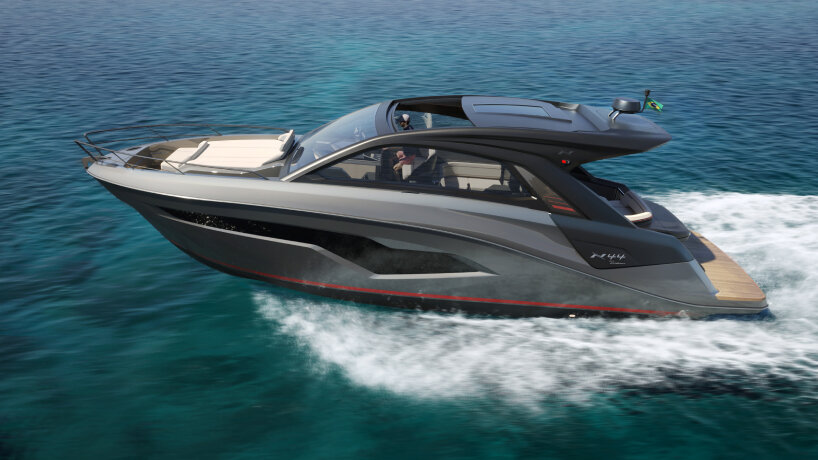
NX 44 boat
SS: We love to find the right balance between elegance and performance in all our projects. Performance is a very important keyword for us. When we reach the right balance between performance and elegance, we call it the Pininfarina style. This combination is somewhat intangible, but it represents the connection between performance and elegance. Elegance is not just the aesthetic beauty of a project or object; it means simplifying complexity.
A car, for instance, is a complex object. Our role in our 100 years of history has been to give elegance to this technological and complex object. We have designed more than 100 Ferraris, which reflects our role. When we talk about performance, it is not just technical performance.
DB: So, there are quite a few keywords you both mentioned here: human relationship, biophilic nature-inspired designs, and that performance and elegance don’t technically correlate with aesthetics. In line with this, Claudio, do you have specific criteria when Pininfarina of America takes on a project from a business point-of-view?
CDS: I don’t think there’s a specific template. There should be mutual respect from both sides: the client and Pininfarina. The most important conversation at the beginning is to look at the project and its characteristics, such as location, geography, configurations, and positioning. We also consider the level of innovation this project has in its industry. Those are all considerations we take into account when someone approaches us to design something with Pininfarina. There’s no specific template, but in the past, we have said no to several projects.
The initial conversation with the client is where we capture the vision. There should be a common vision to achieve a successful project. Pininfarina is a design house with a brand and a legacy. A successful project is a matter of reputation because we attach our logo and reputation. The first initial conversation reveals if there’s a qualitative and innovation fit. This assessment is not just about business; it’s about creating something that lasts, makes a difference, and improves the way we live. That’s the key conversation we have in every project. Paolo, feel free to add your view.
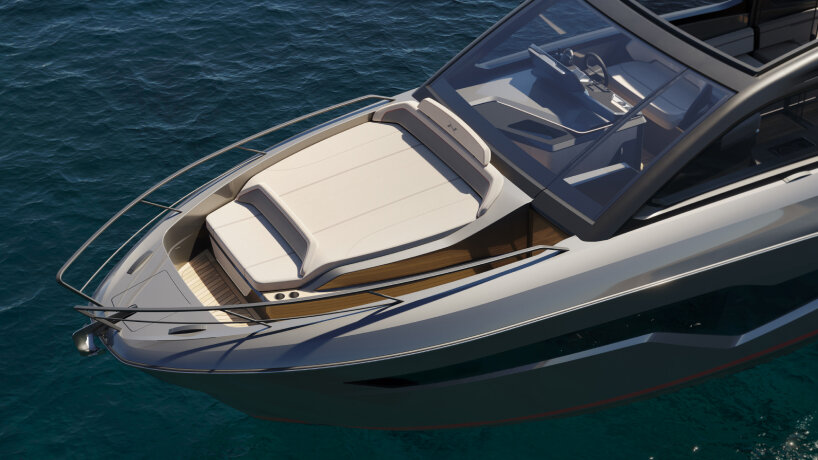
sunbed view of the NX 44 boat
SS: And just to add, one of the most important aspects that ties Pininfarina with a new partner is the project’s message. We care about designing projects with a specific message, which is very important for us. Each Pininfarina project has a specific storytelling and narrative because we seek partners who want to convey a message in the market. This is one of the key ingredients that allows us to choose the right partner for the right project.
PT: I can tell you something interesting about the consequences of taking on a project with Pininfarina of America. We select based on personal relationships and understanding; it’s not about the numbers. We have worked with startups and big corporations, even with an idea from someone who knocked on our door. We are very open to all kinds of projects. The selection is different, but we have a high percentage of repeat clients. I don’t remember any client who has done only one project with us, which I love.
This reflects the strong relationships we build. The storytelling Samuele mentioned is something we create together. A client needs to have a dream, vision, and passion, and we add our love to the project. Normally, we do a second or third project together, establishing long-lasting relationships where clients become friends. When we don’t feel comfortable, perhaps because we believe it will squeeze the brand instead of adding value, or if it feels too speculative, we prefer not to proceed. We still have that luxury.
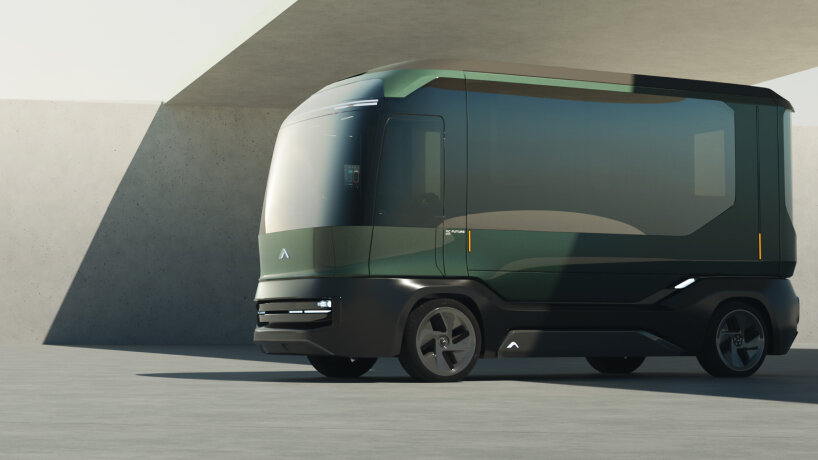
Electric Transformer House
CDS: If I may add a few numbers to Paolo’s point, almost seven clients – specifically 6.8 – out of 10 gave us a second, third, fourth, or fifth project last year. Repeating business is extremely high. This statistic is from 2023. We conducted a Net Promoter Score (NPS) survey, launched by Boston Consulting Group, which is an anonymous survey to assess our customers’ feelings about Pininfarina. We do this every year and received a score of 95 out of 100, which Boston Consulting Group considers stellar.
Our team did an amazing job, and clients appreciate our work, which drives repeat business. Lastly, we celebrated yesterday with the entire team in our New York and Miami offices the Great Place to Work certification for the fourth consecutive year. This team in the Americas has maintained an average score above 90 points over four years, while the average American company scores 57. These numbers may help substantiate some considerations.
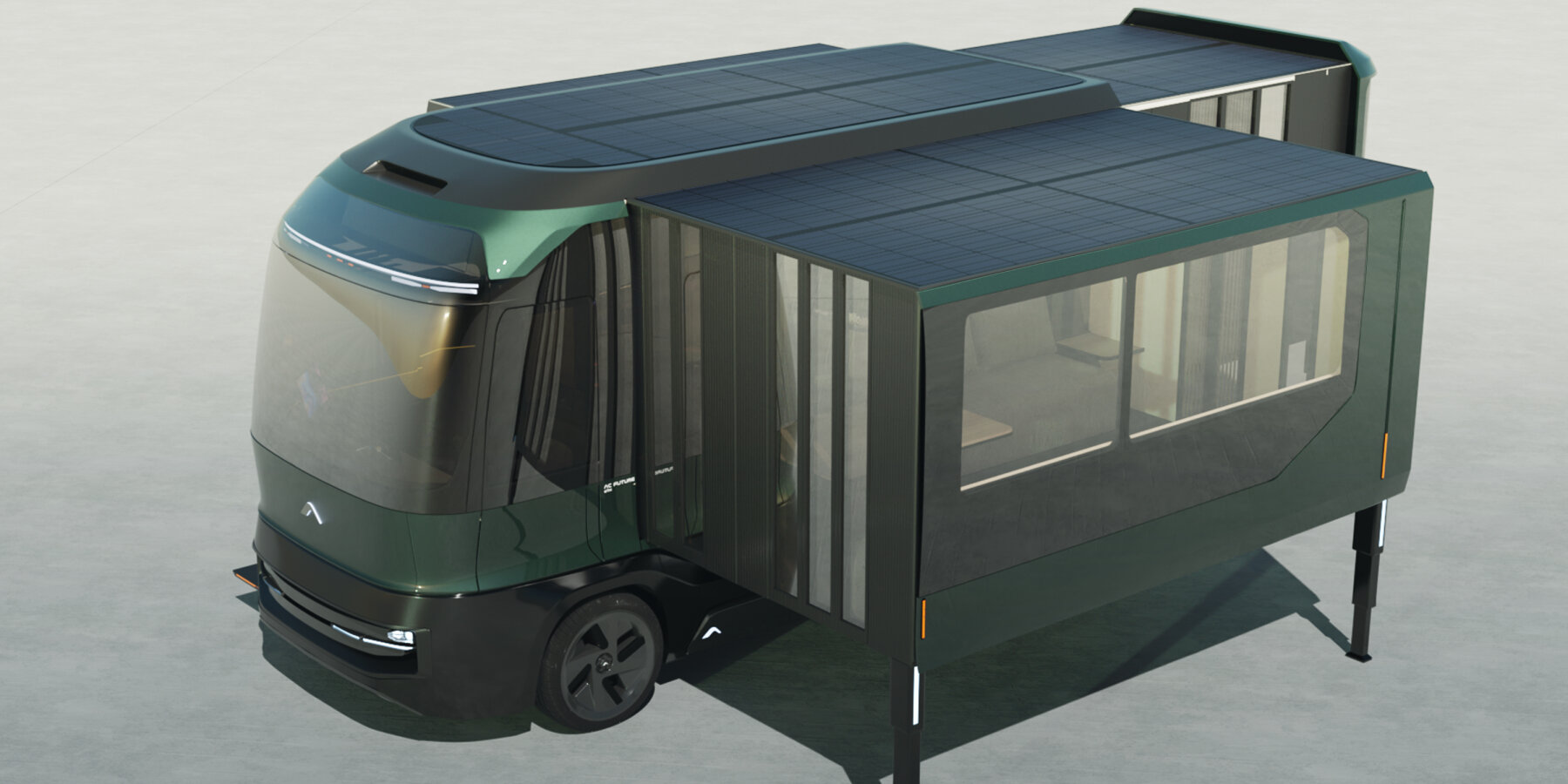
Electric Transformer House with expandable solar roof and sides
DB: You’ve also entered into the lighting installation and design with your upcoming activation and project with VISO for the Design Miami 2024. We read that the theme is about childhood dreams. Ahead of the unveiling, what made you explore this theme, and how does the installation invoke this?
PT: So we are partnering with Viso, who has the capability for special bespoke lighting. We have done a project with them in Fort Lauderdale. We are working together on some projects for special lighting features. We got along well together and wanted to dream more. We came up with the idea of creating an installation that impacts emotions. Our dream is based on a vision I cannot share too much about because I don’t want to reveal everything, but if I need to put a picture to it, it would be a child lying in the grass looking at the clouds. When you see the clouds, you get different shapes and dream about the future in a very positive way. That is the main goal. The results are sculptures flying in the space, which also have illuminations and a video— a full experience. The message we want to deliver is a positive one because we always look to the future in a positive way, even with new challenges.
As a child, you have that pure passion and dreaming, but not only dreaming; you also make those dreams come true. It’s fun, to be honest. When we moved to Miami, we saw this Art Basel event, and I saw many people having fun. I thought, why don’t we have fun too? I mean, it’s not correct to miss out. We had some experiences in the past where we designed an entire garden area with sculptures, benches, and a bar. We created the entire space, and it was also an art installation for an event. It was in brick and very nice. It was supposed to be there for two weeks, but they kept it for three years. It seems they liked it. Now they needed to move, and the installation moved to our project in Fort Lauderdale. Sometimes it’s important to be out of the ordinary with projects and just dream again.
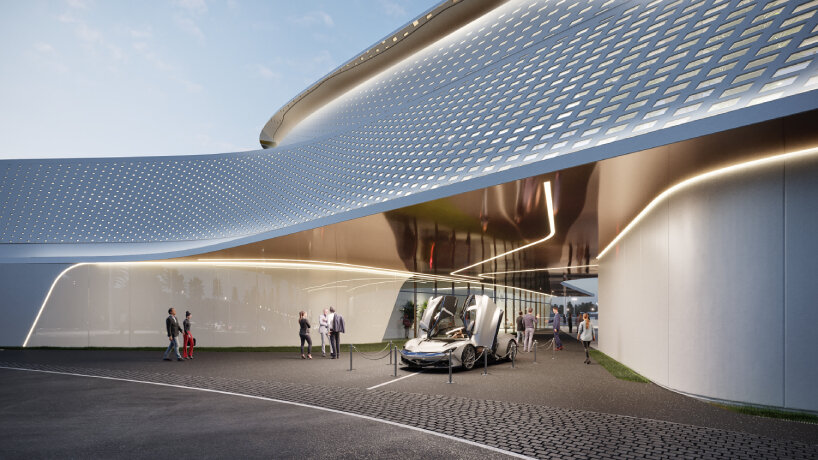
Concours Club Events Campus, entrance view
SS: Out of this installation, art is very important for us because we try to consider architecture, of course, as a form of art, and also to create a relationship between our projects, our architecture, and other forms of art. We design sculptures that are fully integrated with our architecture. Art is another very important ingredient in our design ethos. We like to work with contemporary artists because, again, it’s a learning process.
For us, it’s a very important message, and for artists, their message is basically their form of art. From them, we learn a lot, and we learn how to see the different aspects of our society in different ways. We learn how to deliver different solutions for daily life and design problems. Art is at the center; I would say it is another element at the core of our design research.
DB: Now we’re curious: what were your childhood dreams?
SS: I’ve always been affected by art, and I have been designing forever. Maybe that’s because I grew up with my uncle, who was a graphic designer. I have clear memories of him designing advertising in the 80s with hand drawings—no computers, no software. I spent entire afternoons with him watching him design with an airbrush and a mask. I remember very well the sound of the engine of the airbrush.
I think that was the main thing that unlocked my artistic passion. I always designed; I didn’t know I wanted to be an architect and discovered that later. Another aspect is that I grew up surrounded by beauty because I grew up in Florence. Whenever you walk, you have art around you. You have incredible beauty, so it helps.
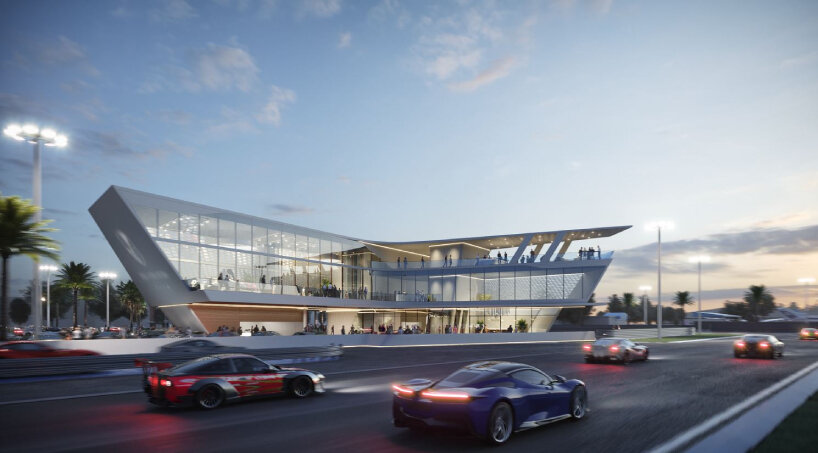
Concours Club Events Campus, exterior view
CDS: In my case, it’s simple. Like many Italians, I wanted to become a soccer player as a kid. I started watching TV. Unfortunately, I didn’t have enough skills to do it, so now I’m here with Pininfarina, in a different industry, taking care of the business side.
PT: I think, if I remember correctly, as a child, I was eager to be a carpenter. I loved the wood, the cars, and the creation process. I also enjoyed art. Being born in Italy and being part of the business world allowed me to experience different things. I remember liking to explore buildings under construction, imagining how they could be. Often, I did this with my father, who probably shared the same passion, even though he was in a different field.
He worked in electronics engineering for Olivetti, which is a different story, but I think he had a passion he never really expressed. I think I inherited that passion. I was always a polite kid but not inclined to follow rules; I didn’t love them. This is why I get along well with Claudio, who is very rule-oriented. We balance each other out. I believe that to be a designer and a creative, you need to break the rules. That’s probably what I took from my childhood.
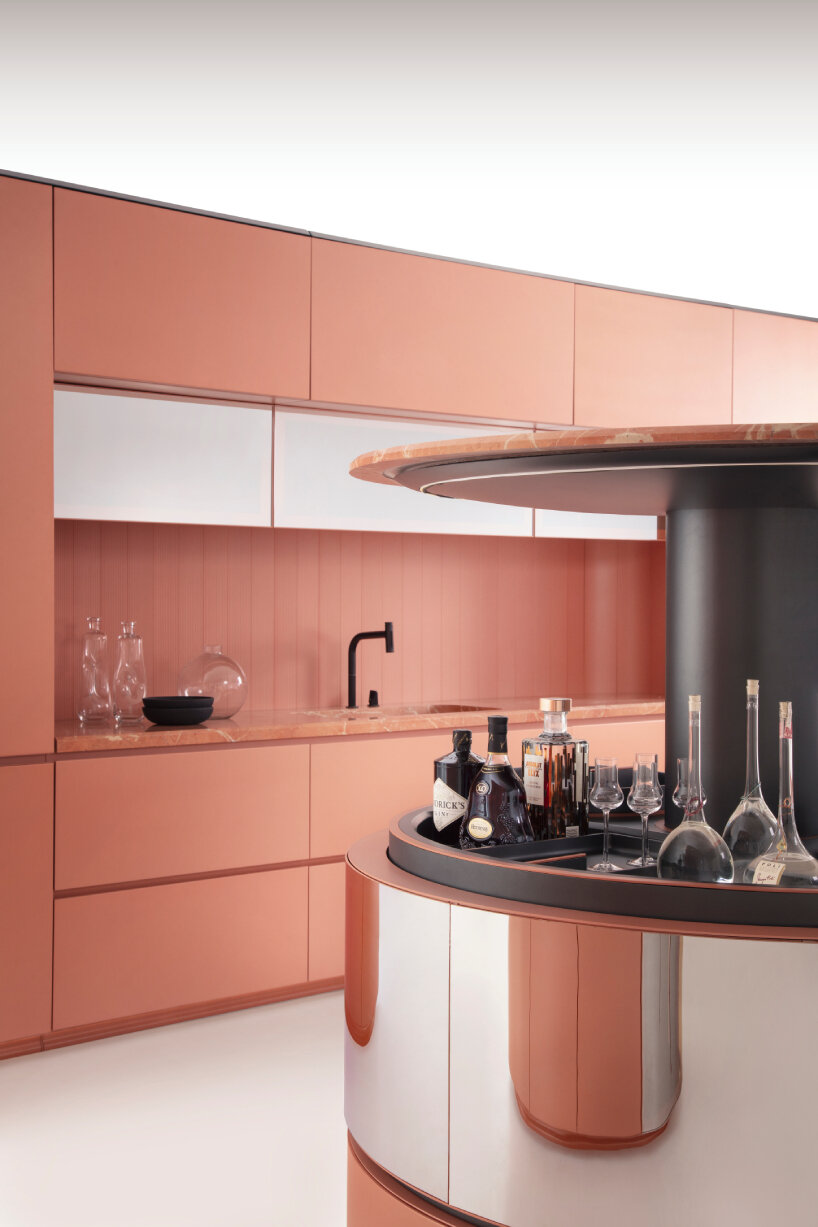
ARCO Kitchen Collection
PT (continued): I used to try to break rules politely. When we design, we also consider context. We often find ourselves in contrast with everyone else doing things a certain way. Why follow that path? It’s not always fulfilling. This love of learning is something I’ve always cherished. I changed schools frequently and had different experiences working at an advertising agency, as a product designer, in architecture school, and in transportation.
I was exploring many disciplines. Sometimes in life, when you look back, the points connect, creating a line. As a family, we traveled a lot. My brother was born in New York, my mother is from France, and we lived in Brazil for many years. Traveling was always a new discovery, and I think that was a very interesting aspect of my learning experience.
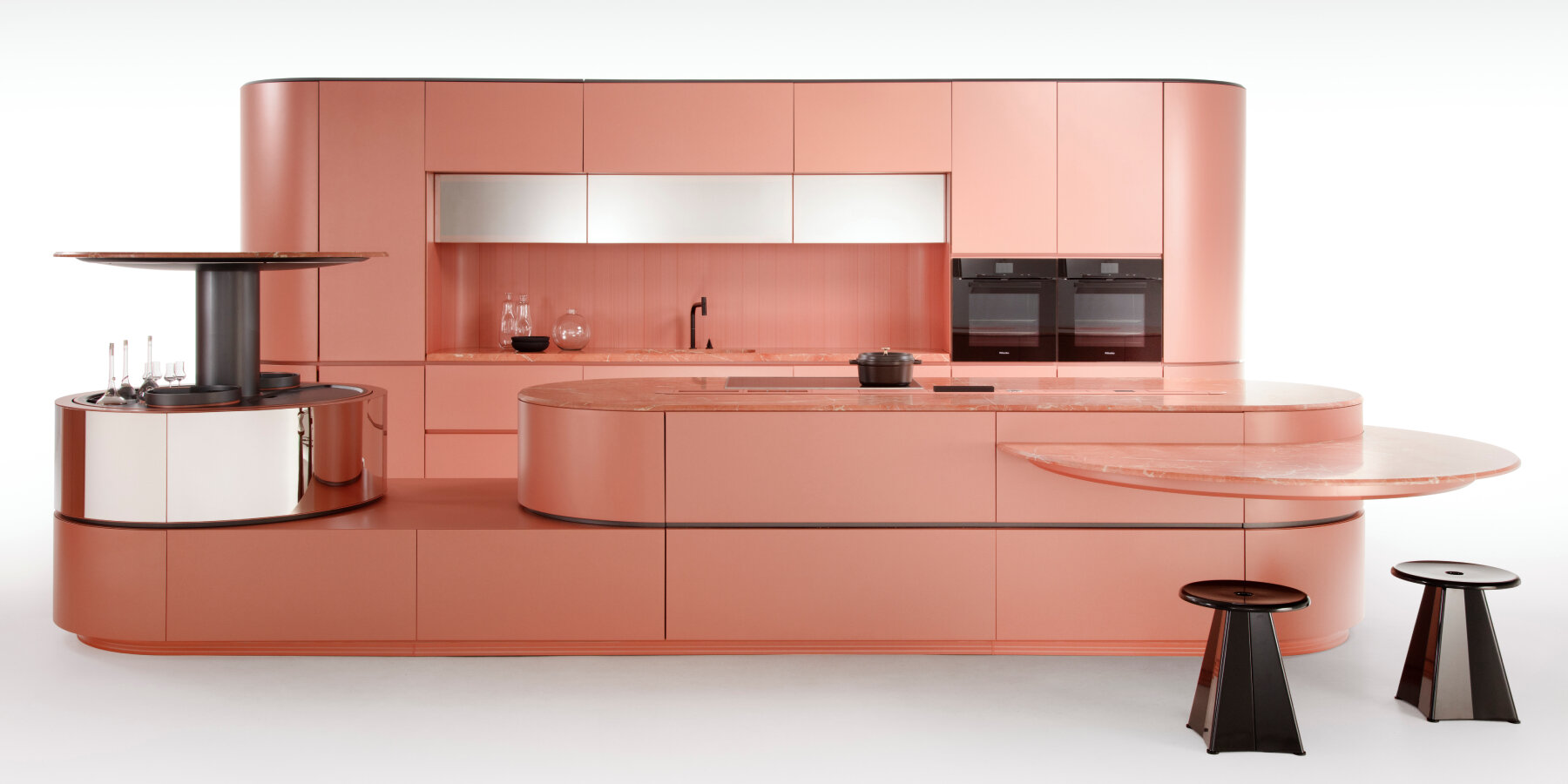
ARCO Kitchen Collection with aluminum profile
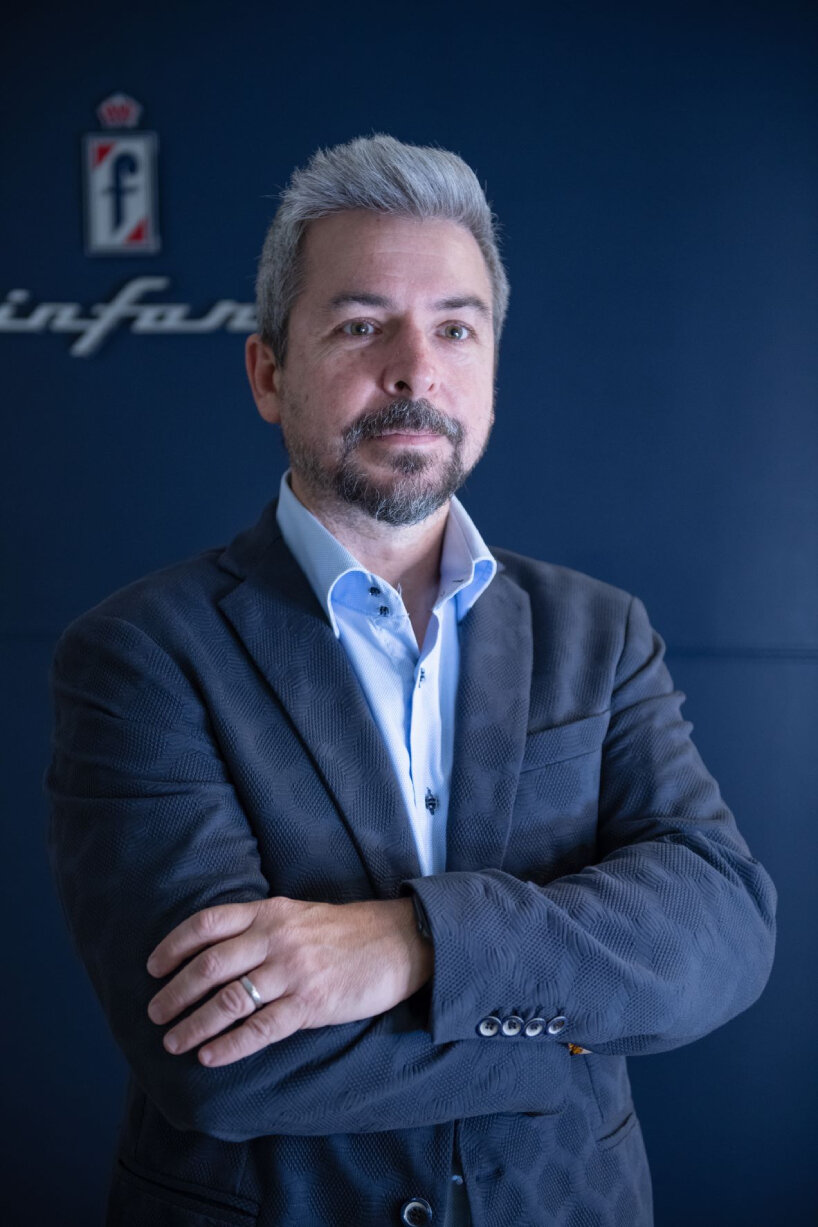
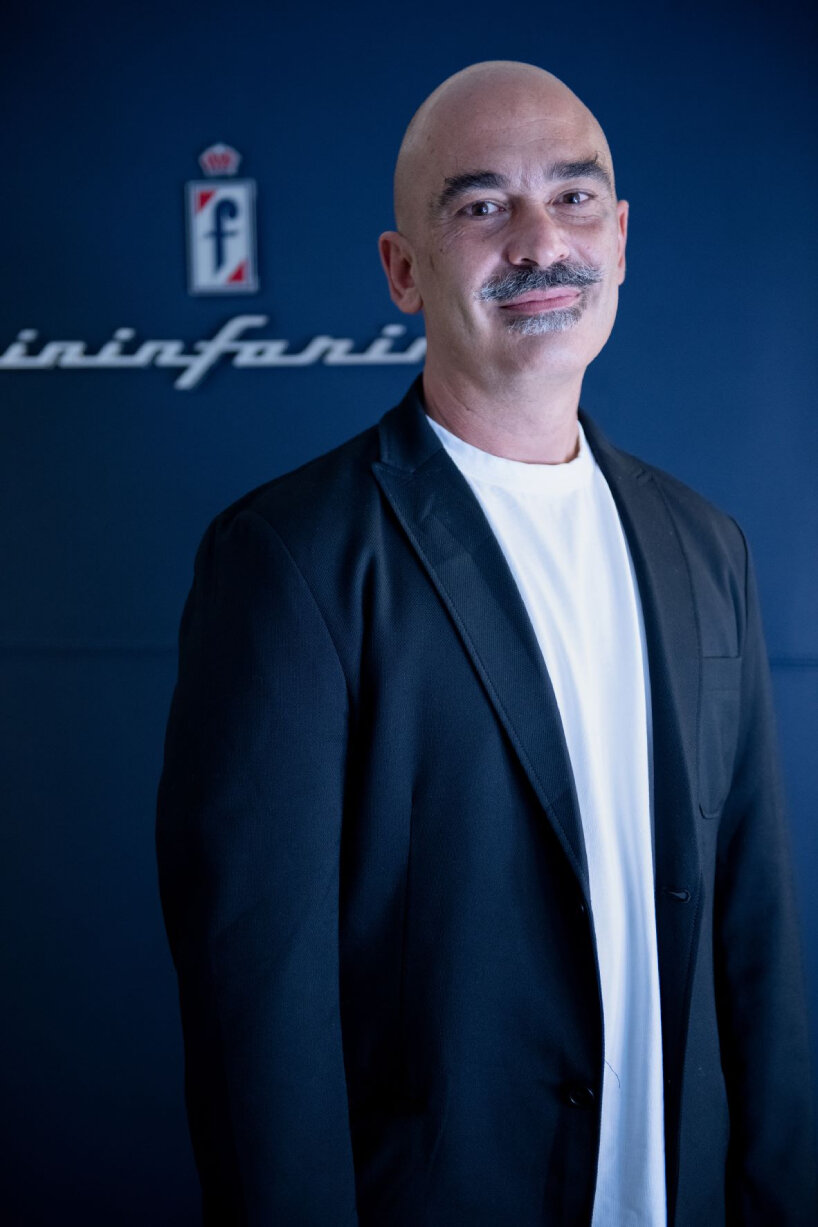
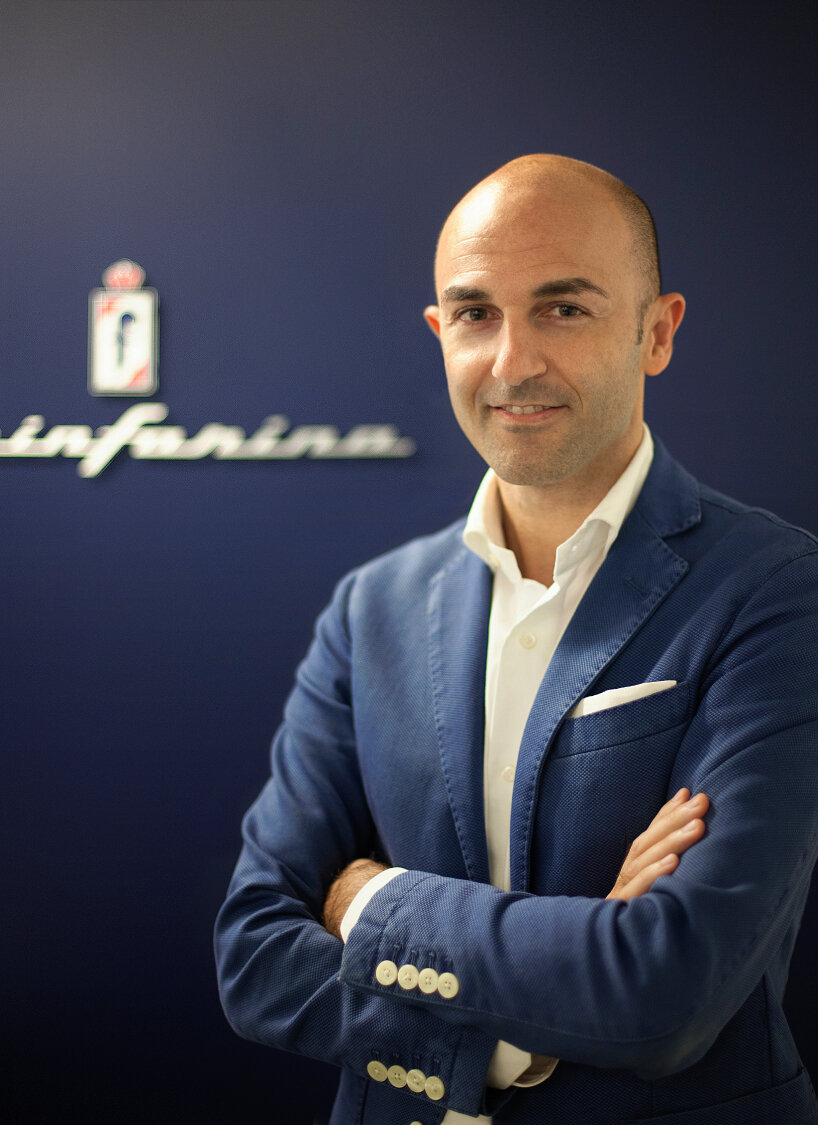
project info:
name: Pininfarina of America | @pininfarinaofamerica
general manager: Claudio da Soller
senior vice president of design: Paolo Trevisan
chief architect officer: Samuele Sordi
